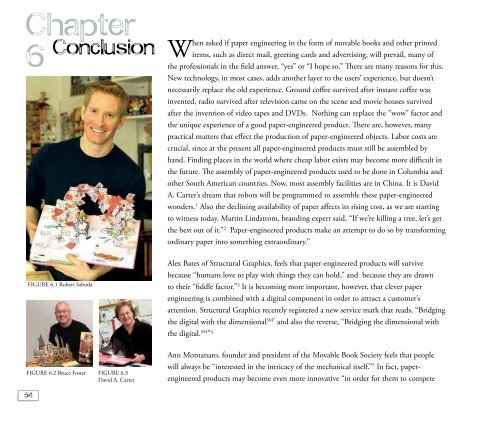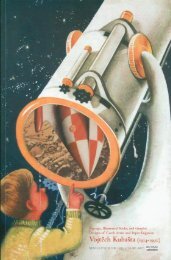NEXT STOP: POP-UPS - The Popuplady
NEXT STOP: POP-UPS - The Popuplady
NEXT STOP: POP-UPS - The Popuplady
You also want an ePaper? Increase the reach of your titles
YUMPU automatically turns print PDFs into web optimized ePapers that Google loves.
Chapter<br />
6<br />
Conclusion<br />
FIGURE 6.1 Robert Sabuda<br />
FIGURE 6.2 Bruce Foster FIGURE 6.3<br />
David A. Carter<br />
W<br />
hen asked if paper engineering in the form of movable books and other printed<br />
items, such as direct mail, greeting cards and advertising, will prevail, many of<br />
the professionals in the field answer, “yes” or “I hope so.” <strong>The</strong>re are many reasons for this.<br />
New technology, in most cases, adds another layer to the users’ experience, but doesn’t<br />
necessarily replace the old experience. Ground coffee survived after instant coffee was<br />
invented, radio survived after television came on the scene and movie houses survived<br />
after the invention of video tapes and DVDs. Nothing can replace the ”wow” factor and<br />
the unique experience of a good paper-engineered product. <strong>The</strong>re are, however, many<br />
practical matters that effect the production of paper-engineered objects. Labor costs are<br />
crucial, since at the present all paper-engineered products must still be assembled by<br />
hand. Finding places in the world where cheap labor exists may become more difficult in<br />
the future. <strong>The</strong> assembly of paper-engineered products used to be done in Columbia and<br />
other South American countries. Now, most assembly facilities are in China. It is David<br />
A. Carter’s dream that robots will be programmed to assemble these paper-engineered<br />
wonders. 1 Also the declining availability of paper affects its rising cost, as we are starting<br />
to witness today. Martin Lindstrom, branding expert said, “If we’re killing a tree, let’s get<br />
the best out of it.” 2 Paper-engineered products make an attempt to do so by transforming<br />
ordinary paper into something extraordinary.”<br />
Alex Bates of Structural Graphics, feels that paper-engineered products will survive<br />
because “humans love to play with things they can hold,” and because they are drawn<br />
to their “fiddle factor.” 3 It is becoming more important, however, that clever paper<br />
engineering is combined with a digital component in order to attract a customer’s<br />
attention. Structural Graphics recently registered a new service mark that reads, “Bridging<br />
the digital with the dimensionalSM” and also the reverse, “Bridging the dimensional with<br />
the digital. SM ” 4<br />
Ann Montanaro, founder and president of the Movable Book Society feels that people<br />
will always be “interested in the intricacy of the mechanical itself.” 5 In fact, paperengineered<br />
products may become even more innovative “in order for them to compete<br />
with digital media,” says Bruce Foster, paper engineer. 6 Paper-engineered products may,<br />
however, make up a smaller part of the market share as we move into the digital age. 7<br />
Shawn Sheehy, book artist/paper engineer has many thoughts about the subject. “Popup<br />
books will remain relevant as a reaction to computers. People and cultures have<br />
always had sacred texts. So, there is a long history of regarding books as sacred. With the<br />
expansion of digital media, humans feel a sense of loss. This feeling of loss supports the<br />
idea that books have a greater sense of preciousness.” 8<br />
Steven Van Dyk explained, “In the folded paper realm, there’s still much to do.” 9 He<br />
considers pop-up books an affordable and portable form of art – “. . .an art form of this<br />
time”. 10 Robert Sabuda said, “I think that young people (and their parents and caregivers)<br />
are overwhelmed by our increasingly electronic world. A pop-up book is a nice break<br />
from that but still the offers interactivity and magic we associate with electronics.” 11<br />
Although most paper engineers making a working today are self taught, there is a new<br />
crop of designers that are formally taught in schools of higher learning, not to mention<br />
the increase of interest by enthusiasts who take workshops with the pros. It seems<br />
plausible that an increasing number of paper engineers will mix traditional and electronic/<br />
digital media in the future because it will become more available to them. But, there<br />
will also be those paper engineers who will remain purists and only work with paper as<br />
their medium. Either way, paper engineering and its influence will continue on into the<br />
foreseeable future.<br />
In closing, a quote by Ellen G. K. Rubin,”<strong>The</strong> Pop-Up Lady”, who is the premier collector<br />
and historian of all things movable, says it all. “A picture is worth a thousand words, but a<br />
pop-up is worth a million.” 12<br />
FIGURE 6.4 Alex Bates<br />
54 55<br />
FIGURE 6.5<br />
Ann Montanaro<br />
FIGURE 6.7<br />
Stephen Van Dyk<br />
FIGURE 6.6<br />
Shawn Sheehy<br />
FIGURE 6.8<br />
Ellen G. K. Rubin



